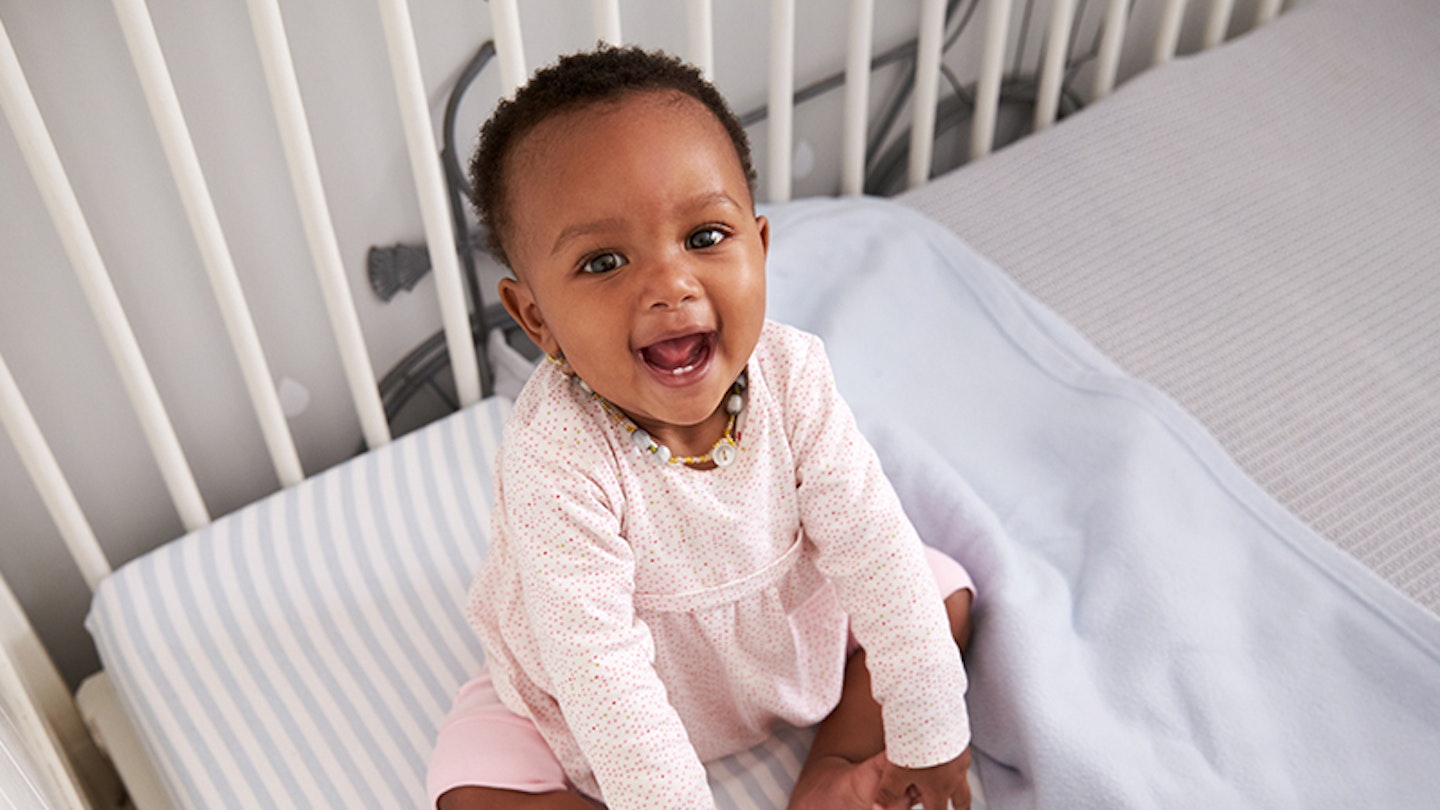
Medically Reviewed by: Dr Sara Kayat
It probably doesn't feel like two minutes ago that you first held your newborn in your arms and now they're hitting so many new milestones! While there are many baby milestones to celebrate in the early months - the first smile, the first giggle, the first roll; sitting up is a big one. At this point they become more able to play with toys and engage with the world around them.
The way you communicate and play will change, with the newfound ability to support themselves upright. It takes time, and every baby is different, but once their neck and back muscles are strong enough, and they've figured out how not to topple over, they'll be doing it on their own. Before you know it your baby will start to crawl, then stand and then be walking! So if your little one is getting stronger and mastering other milestones, you could be wondering when do babies sit up?
Sitting up by themselves will make a huge difference for your little one, who will have a whole new perspective on the world. With the help of Paediatric Occupational Therapist, Emma Hubbard, and Dr Sara Kayat, we've taken a look at when babies sit up and how you can help your baby sit up using some simple exercises.
When do babies sit up?
Dr Sara Kayat says that typically, babies learn to sit up unsupported between about 6 months to 9 months. Between 4 months and 6 months, you might find that they'll start to sit up but need to prop themselves up with their hands. But as with all areas of baby development, babies reach this milestone at different times.
Once your baby has developed the muscles to help them hold their head up, they'll eventually start sitting up for a couple of minutes without support by the time they're 8 months old. After a couple of minutes, any baby is bound to topple over due to muscle fatigue or loss of balance.
Babies develop at different rates for a multitude of reasons, so try not to compare yourself too much to friends' little ones – focus on your baby's own unique milestones instead.
How do babies learn to sit up?
Paediatric Occupational Therapist and mum of two Emma Hubbard says, "Generally there's a natural progression they will go through, they need to have sufficient head control first. Once they've got head control they're then able to start sitting with support from you at their ribs, torso or hips. Then once they've got that trunk control you'll be able to move your hands away and your baby might be able to sit propping up on toys or using their arms to pop themselves up into the sitting position."
Stages of learning to sit up:
1.) First, they'll learn to raise their head while lying on their stomach.
2.) After that, they'll be figuring out how to prop themselves up on their arms and hold their chest off the floor, like a sort of baby push-up.
3.) Gradually, over the next 3 months, your baby may be able to sit for a matter of seconds without assistance, but you should surround them with pillows at this point in case they topple. They'll probably hold themselves up with their arms in what's known as a 'tripod sitting'.
4.) Eventually, they'll be sitting upright on their own, by about 8 months.

Emma adds, "As their muscles continue to get stronger they'll be able to sit independently without using their arms to help them prop into sitting, and they'll start reaching out with that arm. As they reach their body adjusts to that change in balance and then they're able to coordinate their muscles to bring themselves back up to sitting."
How can I help my baby to sit up?
While all babies will sit up at their own pace, there are a few exercises you can do to help your little one along the way.
Tummy time:
Your first job is to encourage them to start raising their head, while they're face down during tummy time. Play a game where you get down on their level and then prompt them to mirror you and look up to the sky. This will help strengthen their neck muscles and develop head control, which is key for sitting up.
Different sitting positions:
Once your baby has good head control and they can hold their head up without your support, then you can start working on developing their sitting skills by practicing different sitting positions.
Exercises :
Emma recommends trying out these exercises to help baby sit up:
"The first position you can do is when you're holding your baby in sitting when they're on your lap, you can provide support to them on their ribcage, and as they start to get stronger you can start to move your hands down their torso so that it's just on their hips."
"When they just require support at the hips, start to gently and slowly tilt their body to the side, very slightly, and you'll notice that baby will activate those side muscles and bring them back up to sitting. This helps them to strengthen those muscles."
"Another sitting position you can do with your baby is when you're sitting on the floor with them, you can place them in between your legs, so your legs are out straight and your thighs can provide that side support. As with the first exercise, you can provide support with your hands on their ribcage, torso and then hips."
Strengthening exercises
Once your baby becomes a fairly confident sitter, you can place toys and objects just out of reach, to hold their attention as they learn to balance using their arms. They'll begin to reach out with one hand, strengthening their muscles in preparation for sitting up without using their hands for support.
Can I use a seat to help my baby sit up
If you think your baby might be struggling to get the hang of sitting up by themselves, a floor seat or an activity seat could be a useful tool. These seats sit on the floor, and they're a great place to sit your baby safely while supporting their back. Many of them also include fun toys to make sitting a rather fun experience for your baby. These seats will help your little one get used to sitting in that position without the risk of toppling over. However, Dr Sara Kayat recommends using these in moderation. "While these seats can be super convenient and support a baby's back and keep them upright, overuse can hinder natural muscle development. Babies may benefit more from natural play and movement on the floor, which encourages muscle strengthening and balance."
What do I do if my baby doesn't sit up?
If your baby isn't able to hold their head up steadily by the time they're about 4 months old and hasn't started learning to prop themselves up on their arms soon after, or is unable to sit unsupported by 9 months, it's probably wise to mention it to your baby's doctor.
If there is an issue with head control, it's worth addressing now, as this will form the foundations for crawling, standing and eventually walking. Something to keep in mind – premature babies may reach this and other milestones later than full-term babies so Dr Kayat recommends using an adjusted age (based on their due date rather than birth date) when assessing developmental milestones for premature babies.
Paediatricians also recommend waiting until your baby is sitting with minimal support before starting them on solid foods.
Will my baby sit before crawling?
Your little one is much more autonomous when they can sit up, so they'll be experimenting with lunging forward pretty soon. This movement could happen as early as 6 months old or 7 months and they could be fully crawling by 10 months.
To make sure you're prepared for your little one being more mobile, it's important to go through a baby-proofing checklist in the house as soon as possible. Make sure doors are locked, electrical outlets are covered and furniture is stable so your little one can safely make the most of their new-found freedom.
About the experts
Dr Sara Kayat studied medicine at King’s College London, where she also achieved a BSc in Physiology and has a diploma in Sexual and Reproductive Health. Sara has a keen interest in surgical specialties, such as ENT and Orthopaedics, which she puts into general practice by having a weekly minor surgery clinic. When not in clinic, Dr Sara is resident GP on ITV’s This Morning and has featured on shows such as GPs Behind Closed Doors (Channel 5) and 12 Hours to Cure Your Street (UKTV). Her first book How to Have a Baby, published earlier this year, is an empowering, unbiased guide and essential toolkit for pregnancy, labour, birth, breastfeeding and your baby’s first year.
Emma Hubbard is a Pediatric Occupational Therapist with over 12 years of clinical experience. She received her Bachelor's Degree in Occupational Therapy from the University of Newcastle. Emma is the founder of Brightest Beginning and writes about all things child development, sleep, feeding, toilet training and more.
About the author
Stephanie Anthony is the Deputy Digital Editor at Mother&Baby and auntie to four aged 7 to 2 months old. With a particular interest in health, she loves discovering products that make parent’s lives easier.
